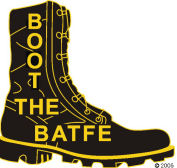

Ownership of Arms Protected under Takings,
Second Amendment, Fourteenth Amendment

By Dean Weingarten. Sept 12, 2022
Article Source
On August 30, 2022, a three judge panel in the Third Circuit Court of Appeals unanimously ruled the Pennsylvania government violated the Takings clause, the Second Amendment, and the Fourteenth Amendment when they refused to return a gun collection of the parents of a man who was convicted of murder.
The parents never committed a crime. The state never used the parents' gun collection as evidence. From a list of property, this correspondent estimates the 47 guns, accessories, computers and other property as valued at $40,000 and up.
The State refused to return the parents' property, under the rule of force: we have them and we won't give them back.
After their son had lost his appeal, the parents asked for their property back. It had not been used as evidence in the case. The state refused. The parents sued in federal district court under U.S. 42:1983, civil rights act. The case was filed on June 10, 2020.
The District court ruled against the parents.
The parents appealed to the Third Circuit Court of Appeals.
The appeals court ruling, written by Judge Bibas, appears to be unanimous (no dissent was seen), and very strongly written. The Bruen decision was important in this case. From the order of the three judge panel:
BIBAS, Circuit Judge. Although police may seize potential evidence using a warrant, they may not keep it forever. Yet they did that here. After a man assassinated a Pennsylvania State Trooper and injured another, troopers seized his parents’ guns. The government never used the guns as evidence. And eight years after the crime, once the son lost his last direct appeal, the officers still refused to return them—even though the officers do not claim that the parents or the guns were involved in the crime.
Because the parents were never compensated, they have a takings claim. And because they lawfully owned the guns, they have a Second Amendment claim too. But since they had a real chance to challenge the government’s keeping the guns, they got procedural due process. So we will affirm in part, reverse in part, vacate in part, and remand.
The court made strong statements affirming the Second Amendment protects arms from being arbitrarily confiscated, even if compensation is made:
II.BY HOLDING ON TO THE PARENTS’ GUNS AFTER THE CRIMINAL CASE ENDED, THE OFFICIALS INFRINGED THEIR RIGHT TO KEEP ARMS
The Second Amendment guarantees “the right of the people to keep and bear Arms.” According to the parents, the officials validly seized their guns under a warrant, but violated that right by refusing to return them. To decide that claim, we ask whether the constitutional text and “this Nation’s historical tradition” permit holding on to the guns. N.Y. State Rifle & Pistol Ass’n, Inc.v. Bruen, 142 S. Ct. 2111, 2126 (2022) (abrogating United States v. Marzzarella, 614 F.3d 85, 89 (3d Cir. 2010), which set forth our previous framework for evaluating Second Amendment challenges). They do not. We hold that unless an exception applies, the Second Amendment protects a person’s right to keep his lawfully owned guns.
(snip)
The government notes that the Takings and Due Process Clauses more clearly protect private property. Walters, 660 F.3d at 317; Schwab & Sprankling at 167–68. So, it suggests, the Second Amendment provides “not a property-like right to a specific firearm,” but just a general right to buy guns. Houston, 675 F.3d at 445.
We disagree. We would never say the police may seize and keep printing presses so long as newspapers may replace them, or that they may seize and keep synagogues so long as worshippers may pray elsewhere. Just as those seizures and retentions can violate the First Amendment, seizing and holding onto guns can violate the Second. The Second Amendment may let the government outlaw specific types of weapons—perhaps “dangerous and unusual weapons.” Heller, 554 U.S. at 627 (dicta); accord Bruen, 142 S. Ct. at 2143; Eugene Volokh, Implementing the Right to Keep and Bear Arms for Self-Defense: An Analytical Framework and a Research Agenda, 56 UCLA L. Rev. 1443, 1548 (2009). But as we have explained, it does forbid unjustifiable burdens on the right to “keep” one’s own arms.
And that protection is not redundant of more property-focused protections. For instance, the Takings Clause allows seizures so long as the government pays “just compensation.” But the Second Amendment appears to forbid “disarm[ing] private citizens” even if the government compensates those citizens for their property. Cf. Heller, 554 U.S. at 591–92. The other guarantees do not prevent this one from applying too.
This is a strong ruling restoring Second Amendment rights. As a Circuit Court ruling, it is a precedential ruling which applies to the entire Third Circuit. The Third Circuit includes Pennsylvania, New Jersey, Delaware and the District of the Virgin Islands.
For New Jersey, Delaware, and the District of the Virgin Islands, this is a tsunami in firearms law, potentially washing away decades of Second Amendment infringements.
The long awaited Bruen decision is restoring Second Amendment rights by affirming the "text and history" requirement for interpreting the plain language of the Constitution, set forth in the Heller decision.
©2022 by Dean Weingarten: Permission to share is granted when this notice and link are included.
![]()

























